I had the greatest of intentions to share a glimpse into the life of another DOM team member today through my "Interview with an Antarctician" videos, but both Yo and Chip found themselves very busy preparing water samples and equipment in anticipation of lots of great lab work in the weeks ahead. Just as I was beginning to despair that I would have no fabulous event or idea to share with all of you today, Yo came zooming into the lab to let me know that there were Weddell seals on the ice very close to the edge of town. YeeHaw! I love seals and knew I could get within range of a few decent photos. Whew, I found my subject for the day and a better topic than writing about how I spent 8 hours filtering dirty water through a very fine meshed filter.
 Smile
Smile
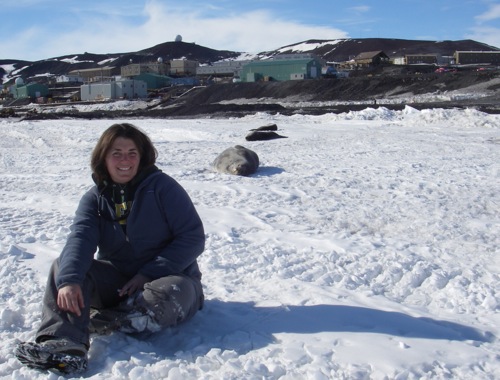 Sarah and Weddell Seals on the ice with McMurdo Station in the background.
Sarah and Weddell Seals on the ice with McMurdo Station in the background.
Weddell Seals, Leptonychotes weddellii, are common marine mammals to see on and around the Ross Ice Shelf in Antarctica. There are approximately 800,000 Weddell Seals in Antarctica. If you took two of me and stacked me one on top of the other I would only be 6 inches taller than a Weddell Seal is long. I am letting you do the math on this one; I am five feet three inches tall. What is the average maximum length of a Weddell? On just a diet of fish, squid, and krill, a Weddell Seal eats enough to weigh around 1000 pounds as an adult! Often, these seals are found hauled out on the ice near a large hole they chew out of the ice using their canine teeth. (Dentists reading this journal, I know your are shuddering at the thought!)
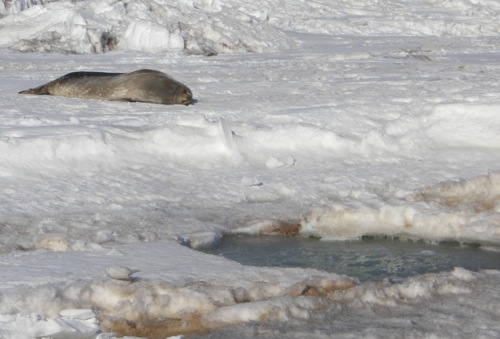 Weddell Seal and, in the foreground, the "door" from the Ross Sea to the Ross Ice Shelf.
Weddell Seal and, in the foreground, the "door" from the Ross Sea to the Ross Ice Shelf.
Weddell Seals are docile animals, which belies their large size. Humans can get close to them, but out of respect for another fabulous mammal, we all tend to give the Seals a wide berth when we are viewing them in Antarctica. The zoom feature on a camera is very helpful when watching Weddell Seals on the Ross Ice Shelf.
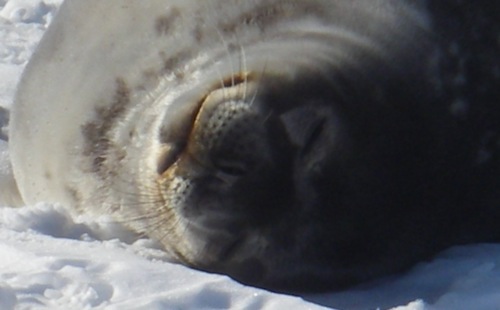 The zoom on my camera helped me capture this photo without waking the seal.
The zoom on my camera helped me capture this photo without waking the seal.
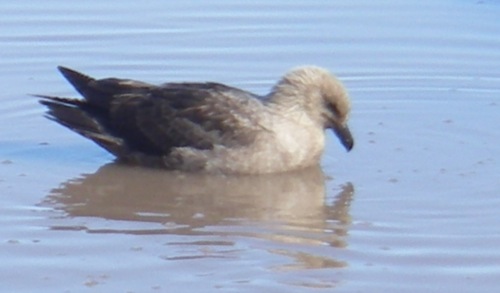 Warm weather brings flowing streams and a chance to grab a bath!
Warm weather brings flowing streams and a chance to grab a bath!
On the way out to the ice Yo and I came across a Skua taking a little bath in a runoff stream crossing one of the many dirt roads that braid through McMurdo Station. A skua (pronounced "skoo-ah") is a close relative to birds in the gull family. In fact, I think the skua, Catharacta maccormicki, looks like a juvenile gull on steroids! Their coloring remains the brownish-grey of a juvenile gull throughout their life. When I first arrived at McMurdo Station, I was warned about the brazenness of the skua. They are an opportunistic bird with very little fear of humans and, as a result, are known to dive-bomb humans walking around outside with food in their hands to snag themselves a delicious snack!
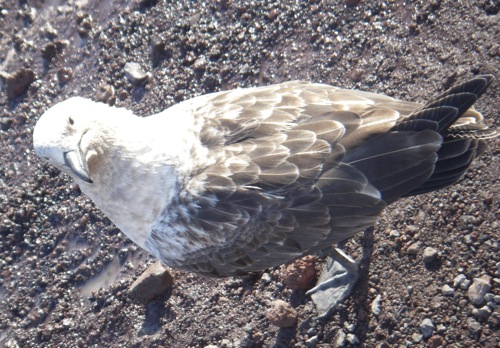 This bird was waiting next to a BBQ for someone to accidently drop a burger.
This bird was waiting next to a BBQ for someone to accidently drop a burger.
I had a chance to see a few Adelie Penguins running around on the ice a couple days ago, but they were so far away that my view came only with the help of a telescope. There was no way to get out to the Penguins because the ice on the Ross Ice Shelf around McMurdo Station is getting a little dicey to drive or walk on because we are experiencing wonderful summer weather that is causing the ice to crack. I did see evidence of penguins on a field trip I took to some Ice Caves a couple weeks ago. There is a very good chance that I will visit an Adelie Penguin rookery at Cape Royds with Chip and Yo soon. Keep on checking back for pictures of actual penguins!
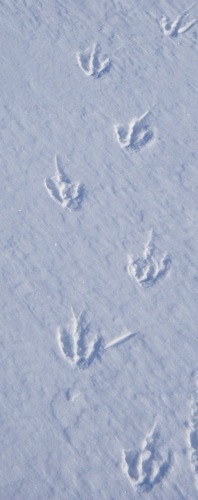 Penguin tracks- now where is the track maker?!
Penguin tracks- now where is the track maker?!
